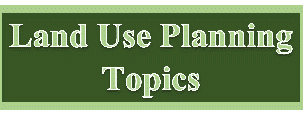Land Use Planning Topics
Land Tools Compendium: Green Infrastructure
References that have links are freely available on the internet.
Alberta Environment and Parks (2014). Efficient Use of Land: Implementation Tools Compendium. Government of Alberta.
Created in 2014 by the Government of Alberta, this compendium outlines tools and practices to implement strategies for the efficient use of land. The strategies are targeted to planners, landowners and developers, public land managers, and public service providers – anyone involved in land use decision making. Some of the strategies have been tested and applied within Alberta and other strategies are adapted from planning practices around the world.
Bitting, J. & Kloss, C. (2008). Managing wet weather with green infrastructure- Municipal handbook: Green infrastructure retrofit policies. United States Environmental Protection Agency
Existing development, especially in urbanized and urbanizing areas, is responsible for currently degraded water quality and stream conditions. Changes in land cover and the increased imperviousness of the urban environment have resulted in larger volumes of runoff traveling at faster velocities. This has caused serious streambank erosion and has compromised aquatic habitat. Many of these areas were developed without adequate stormwater controls and must be addressed if urban streams are to be restored and water quality is to be improved nationwide. It should be noted that most stormwater regulations are intended to limit the increases in pollution associated with new development, or to curb flooding, but do not specifically address the hydrologic modifications associated with runoff from existing development.
Caldwell, A. (2017). Want resilient cities? Try a national policy on green infrastructure [blog post]. Huffpost.
Outside the world of environmental and/or municipal infrastructure and urban design policy, you could be forgiven for not knowing what green infrastructure is. You may not have given more than a passing thought to the form and function of your urban green spaces, how urban water flows, or how big your watershed is.
Environmental Protection Agency (2008). Managing wet weather with green infrastructure - Municipal handbook: Funding options. United States Environmental Protection Agency
Securing adequate, sustainable sources of funding for managing wet weather presents a significant challenge for towns and cities across the United States, and financial constraints frequently hinder the implementation of effective programs and practices at the local level. This situation is often especially true for green infrastructure approaches, not necessarily because they are more expensive than traditional management approaches (in fact often they are less expensive), but because they do not necessarily fit existing funding frameworks. In many cases, green infrastructure is simply another item on the community “to-do” list that cannot (and will not) be addressed without developing alternative funding mechanisms.
Environmental Protection Agency (2009). Managing wet weather with green infrastructure - Municipal handbook: Incentive mechanisms. United States Environmental Protection Agency
This chapter includes a list of incentive mechanisms currently being used by municipalities around the United States. The incentives have been organized categorically by type of incentive.
Lukes, R. & Kloss, C. (2008). Managing wet weather with green infrastructure - Municipal handbook: Green streets. United States Environmental Protection Agency
By design and function, urban areas are covered with impervious surfaces: roofs, roads, sidewalks, and parking lots. Although all contribute to stormwater runoff, the effects and necessary mitigation of the various types of surfaces can vary significantly. Of these, roads and travel surfaces present perhaps the largest urban pollution sources and also one of the greatest opportunities for green infrastructure use.
United States Environmental Protection Agency (2017). Green infrastructure in parks: A guide to collaboration, funding, and community engagement
This guide is intended to encourage partnerships between park agencies and storm water agencies aimed at promoting the use of green infrastructure on park lands.
United States Environmental Protection Agency (2017). Green infrastructure modeling toolkit.
EPA has developed innovative models, tools, and technologies for communities to manage water runoff in urban and other environments. The resources in this toolkit incorporate green or a combination of green and gray infrastructure practices to help communities manage their water resources in a more sustainable way, increasing resilience to future changes.






